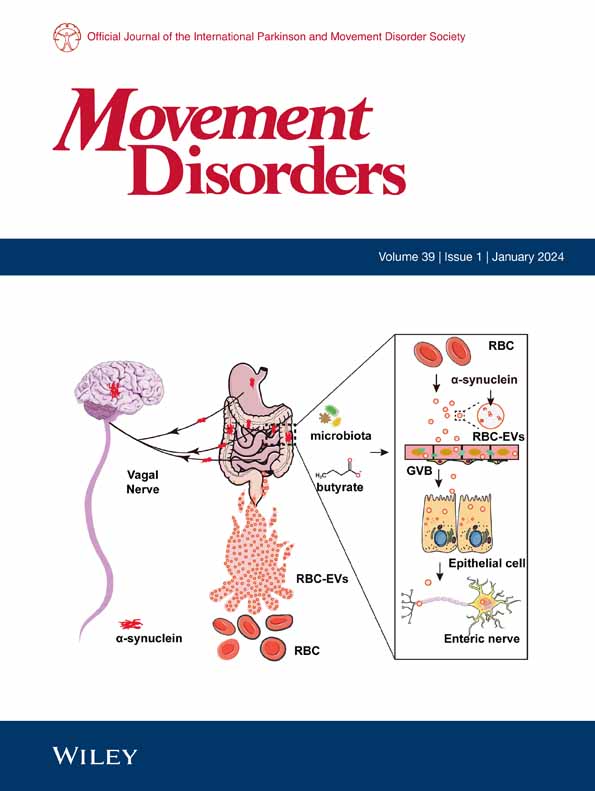配对脑深部刺激可诱导白球内核和丘底核的短期促进作用
IF 7.4
1区 医学
Q1 CLINICAL NEUROLOGY
引用次数: 0
摘要
脑深部电刺激(DBS)在帕金森病(PD)和其他运动障碍患者中引起振荡的局部场电位。对这些神经反应的快速动力学的更多了解可以阐明回路病理生理学,并为神经调节疗法提供新的方法。目的比较白球内(GPi)和丘脑下核(STN)的短期神经可塑性,后者是PD和肌张力障碍的典型功能靶点。方法:在DBS导联植入手术中,我们在不同的刺激间隔和振幅上提供成对的刺激,并记录了未使用的导联接触引起的DBS诱发反应。去除刺激伪影后,通过对脉冲间隔和脑靶对比局部反应的幅度和时间。此外,我们比较了DBS诱发电位与静息局部场电位在同一记录部位的振幅。结果14例STN DBS患者和9例GPi DBS患者中,STN诱发电位的振幅大于GPi。然而,GPi的成对脉冲神经可塑性大于STN。除此之外,两个部位的反应表现出相似的成对脉冲加速和难耐性、发作潜伏期和前两个峰测量的频率。结论单脉冲和成对DBS脉冲引起的STN局部振荡幅度大于GPi。除此之外,反应表现出相似的时间动态和短期神经可塑性。这些发现可以为未来利用传感技术的DBS系统的治疗创新提供信息。©2025作者。Wiley期刊有限责任公司代表国际帕金森和运动障碍学会出版的《运动障碍》。本文章由计算机程序翻译,如有差异,请以英文原文为准。
Paired Deep Brain Stimuli Elicit Short‐Term Facilitation in Globus Pallidus Interna and Subthalamic Nucleus
BackgroundDeep brain stimulation (DBS) elicits oscillatory local field potentials in patients with Parkinson's disease (PD) and other movement disorders. Greater knowledge about the fast dynamics of these neural responses could shed light on circuit pathophysiology and inform novel approaches to neuromodulation therapies.ObjectivesTo compare short‐term neuroplasticity in the globus pallidus interna (GPi) and the subthalamic nucleus (STN), the canonical functional targets for PD and dystonia.MethodsDuring surgery for DBS lead implantation, we delivered pairs of stimuli across various interstimulus intervals and amplitudes and recorded DBS‐evoked responses from unused contacts on the lead. After stimulus artifact removal, we contrasted the magnitude and timing of the local responses by paired pulse interval and brain target. Additionally, we compared the amplitudes of the DBS‐evoked potentials versus resting local field potentials at the same recording site.ResultsIn 14 patients undergoing STN DBS and 9 undergoing GPi DBS, evoked potentials in the STN exhibited greater amplitudes than those in the GPi. However, paired pulse neuroplasticity was larger in the GPi than in the STN. Otherwise, the responses at both sites exhibited similar paired pulse hastening and refractoriness, onset latencies, and frequencies measured by the first two peaks.ConclusionsSingle and paired DBS pulses elicit local oscillations with larger amplitudes in the STN than in the GPi. Otherwise, the responses display similar time dynamics and short‐term neuroplasticity. These findings could inform therapeutic innovation with future DBS systems that utilize sensing technologies. © 2025 The Author(s). Movement Disorders published by Wiley Periodicals LLC on behalf of International Parkinson and Movement Disorder Society.
求助全文
通过发布文献求助,成功后即可免费获取论文全文。
去求助
来源期刊

Movement Disorders
医学-临床神经学
CiteScore
13.30
自引率
8.10%
发文量
371
审稿时长
12 months
期刊介绍:
Movement Disorders publishes a variety of content types including Reviews, Viewpoints, Full Length Articles, Historical Reports, Brief Reports, and Letters. The journal considers original manuscripts on topics related to the diagnosis, therapeutics, pharmacology, biochemistry, physiology, etiology, genetics, and epidemiology of movement disorders. Appropriate topics include Parkinsonism, Chorea, Tremors, Dystonia, Myoclonus, Tics, Tardive Dyskinesia, Spasticity, and Ataxia.
 求助内容:
求助内容: 应助结果提醒方式:
应助结果提醒方式:


